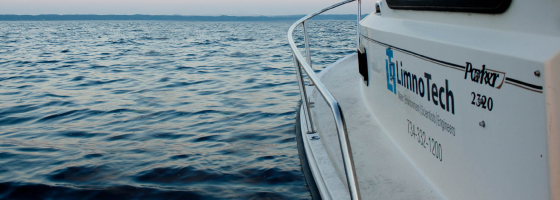LimnoTech’s Buffalo River Project

By Cathy Whiting
The Buffalo River watershed encompasses approximately 445 square miles and drains portions of Buffalo and Wyoming counties in Western New York, including three major subwatersheds: Cayuga, Buffalo, and Cazenovia Creeks. Land use within the watershed is primarily agricultural and woodland in the upper basin; and mostly developed and industrial in the lower basin. The terrain consists of gently rolling dissected glacial plateau along the Lake Erie shoreline. The river passes through a heavily industrialized part of Buffalo before entering Lake Erie.
A portion of the Buffalo River has been designated an Area of Concern (AOC) pursuant to the U.S.-Canada Great Lakes Water Quality Agreement. The AOC includes approximately 6.2 miles of the Buffalo River and the entire 1.4 mile stretch of the City Ship Canal, adjacent to the river. The AOC impact area is characterized by historically heavy industrial development in the midst of a large municipality.
LimnoTech, a water resources and environmental consulting firm in Ann Arbor, Michigan, conducted bathymetry surveys and hydrologic monitoring of the Buffalo River in 2008 to generate data for hydrodynamic modeling of the river. Hydrodynamic and water quality measurements were collected to help establish boundary conditions for the model, support model calibration, and provide information on flow and suspended solids variability over time and a range of flow conditions. This work was part of a series of studies conducted to develop a comprehensive assessment of current conditions in the river, and to provide the data necessary to complete a Feasibility Study (FS) for the Buffalo River AOC.
System Description
Instrumentation was installed in the river to collect velocity and suspended solids data over a six-week period in late 2008. The installations included a downstream transect near the mouth of the river, a midstream transect, and an upstream transect at the end of the navigational channel.
The data collected at the monitoring stations included velocity, surface water elevation, and turbidity. The velocity measurements were collected using side-looking Acoustic Doppler Current Profilers (ADCP) (SonTek Argonaut-SL500), which provided average channel velocities by measuring a broad spectrum of current velocities across the width of the channel. The ADCPs were mounted on pilings at the downstream and midstream locations and on a concrete wall along the bank at the upstream location. In addition, an up-looking ADCP (Teledyne/RDI Workhorse Sentinel) was installed at the mid-stream transect, in approximately the middle of the channel. The Sentinel measured the vertical velocity profile of the water column.
Surface water elevations were monitored at 15 minute intervals using pressure transducers (In-Situ LevelTroll 500). The transducers were located with the ADCPs at the upstream and downstream transects. The surface water elevations were surveyed to vertical reference points located on shore near the equipment installation locations.
Turbidity and temperature were monitored at 15 minute intervals using YSI 6136 turbidity sensors and turbidity also was measured using optical back scatter (OBS) meters. The YSI turbidity sensors were installed on monitoring buoys (NexSens prototype portable data buoys) located in the channel next to each of the ADCP installations. Two sensors were placed on each buoy at approximately 25% and 75% of the river depth to capture the vertical stratification of the river. The OBS meters were installed at the upstream and downstream monitoring buoys at a depth of 75% of the river depth.
All monitoring data was recorded by internal instrument data loggers, or by external data loggers. OBS and YSI turbidity sensor readings were correlated to local suspended sediment concentrations by collecting four series of surface water samples during the monitoring period. Discrete water samples were collected at each of the monitoring buoy installations. These samples were analyzed for total suspended solids concentrations (TSS). The TSS results were coupled with the OBS and YSI raw output readings to provide a suspended sediment calibration curve specific to the river.
Results
The Buffalo River is typically characterized as a slow-moving river; study data demonstrated average low flow conditions of approximately 150 cfs and peak high flow conditions of approximately 6,500 cfs. Due to the low river gradient (17 cm/km) and the generally low flow conditions, both the direction and magnitude of flow in the lower Buffalo River are frequently affected by seiche-related changes in Lake Erie water levels (a seiche is a standing wave or oscillation in a contained body of water). Oscillations in velocity direction and changes in water levels were demonstrated as a result of Lake Erie seiche events and the wave effects in the river. Seiche-induced water-level changes occur over a period of approximately 14 hours; the waves propagate over a period of approximately 1.75 to 2 hours. Smaller internal wave oscillations were observed as a result of the upstream boundary of the navigation channel.
The hydraulic and hydrodynamic conditions of the Buffalo River were modeled over varying flow conditions to demonstrate the flood elevations and velocity and shear stress distributions over a range of flow and seiche conditions. The existing three-dimensional model developed by Joe Atkinson at the University at Buffalo was upgraded to the three-dimensional USEPA EFDC modeling framework and the original model grid was extended upstream. The upgraded model was calibrated to highly resolved velocity and water level data collected during fall 2008. The velocities and shear stresses computed by the model for the various events are consistent with the river’s function as a dredged navigation channel. Results from model simulations demonstrate low velocities and bottom shear stresses throughout the AOC during low flow conditions. During moderate flow events (1-yr interval) model results demonstrated higher velocities in the upstream areas and attenuation of seiche impacts in upstream reaches. An increase in velocities and shear stress was demonstrated during high flow events (10-yr and 100-yr intervals) in narrow sections of the river.
The hydrodynamic modeling studies and investigation of sediment bed properties supports an improved understanding of the sediment transport within the Buffalo River AOC, and an understanding of the long-term stability of the system under wet weather and high seiche conditions.




0 comments